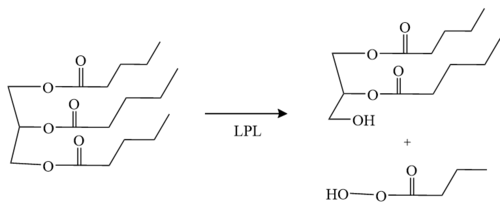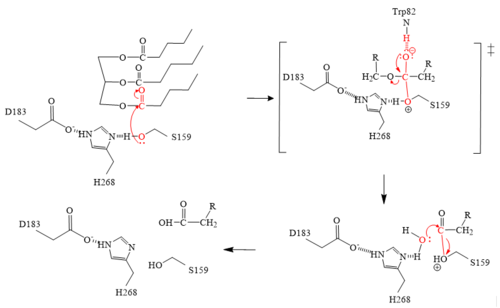User:Hannah Wright/Sandbox 1
From Proteopedia
(Difference between revisions)
| Line 42: | Line 42: | ||
a. The triglyceride binds to LPL’s lipid-binding region in an open lid conformation. | a. The triglyceride binds to LPL’s lipid-binding region in an open lid conformation. | ||
| + | |||
b. The oxygen on S159 is made more [http://en.wikipedia.org/wiki/Nucleophile nucleophilic]. This happens via [http://en.wikipedia.org/wiki/Histidine histidine] hydrogen bonding with the hydrogen on S159’s alcohol group. | b. The oxygen on S159 is made more [http://en.wikipedia.org/wiki/Nucleophile nucleophilic]. This happens via [http://en.wikipedia.org/wiki/Histidine histidine] hydrogen bonding with the hydrogen on S159’s alcohol group. | ||
| + | |||
c. The nucleophilic oxygen attacks the [http://en.wikipedia.org/wiki/Carbonyl_group carbonyl carbon] of one of the fatty acid chains. | c. The nucleophilic oxygen attacks the [http://en.wikipedia.org/wiki/Carbonyl_group carbonyl carbon] of one of the fatty acid chains. | ||
| + | |||
d. This pushes electrons up onto the carbonyl oxygen, creating a [http://www.chem.ucla.edu/~harding/IGOC/T/tetrahedral_intermediate.html tetrahedral intermediate]. This is the oxyanion hole which is stabilized by main chain nitrogen atoms of W82 and L160. | d. This pushes electrons up onto the carbonyl oxygen, creating a [http://www.chem.ucla.edu/~harding/IGOC/T/tetrahedral_intermediate.html tetrahedral intermediate]. This is the oxyanion hole which is stabilized by main chain nitrogen atoms of W82 and L160. | ||
| + | |||
e.One of the lone pairs on the oxygen (in the oxyanion hole) creates a double bond carbon. | e.One of the lone pairs on the oxygen (in the oxyanion hole) creates a double bond carbon. | ||
| + | |||
f. The oxygen-carbon bond between the single fatty acid chain and the [http://en.wikipedia.org/wiki/Diglyceride diglyceride] is cleaved. | f. The oxygen-carbon bond between the single fatty acid chain and the [http://en.wikipedia.org/wiki/Diglyceride diglyceride] is cleaved. | ||
| + | |||
g. H268 hydrogen bonds water, making the oxygen a better nucleophile. Water attacks the carbonyl carbon. | g. H268 hydrogen bonds water, making the oxygen a better nucleophile. Water attacks the carbonyl carbon. | ||
| + | |||
h. The [http://en.wikipedia.org/wiki/Carboxylic_acid carboxylic acid] is formed and the S159 bond is cleaved and re-protonated via H268. | h. The [http://en.wikipedia.org/wiki/Carboxylic_acid carboxylic acid] is formed and the S159 bond is cleaved and re-protonated via H268. | ||
| + | |||
i. The active site is now back in its original state. | i. The active site is now back in its original state. | ||
Revision as of 19:23, 27 April 2021
Lipoprotein Lipase (LPL) complexed with GPIHBP1
| |||||||||||
References
- ↑ 1.00 1.01 1.02 1.03 1.04 1.05 1.06 1.07 1.08 1.09 1.10 Birrane G, Beigneux AP, Dwyer B, Strack-Logue B, Kristensen KK, Francone OL, Fong LG, Mertens HDT, Pan CQ, Ploug M, Young SG, Meiyappan M. Structure of the lipoprotein lipase-GPIHBP1 complex that mediates plasma triglyceride hydrolysis. Proc Natl Acad Sci U S A. 2018 Dec 17. pii: 1817984116. doi:, 10.1073/pnas.1817984116. PMID:30559189 doi:http://dx.doi.org/10.1073/pnas.1817984116
- ↑ 2.0 2.1 Wong H, Davis RC, Thuren T, Goers JW, Nikazy J, Waite M, Schotz MC. Lipoprotein lipase domain function. J Biol Chem. 1994 Apr 8;269(14):10319-23. PMID:8144612
- ↑ Arora R, Nimonkar AV, Baird D, Wang C, Chiu CH, Horton PA, Hanrahan S, Cubbon R, Weldon S, Tschantz WR, Mueller S, Brunner R, Lehr P, Meier P, Ottl J, Voznesensky A, Pandey P, Smith TM, Stojanovic A, Flyer A, Benson TE, Romanowski MJ, Trauger JW. Structure of lipoprotein lipase in complex with GPIHBP1. Proc Natl Acad Sci U S A. 2019 May 21;116(21):10360-10365. doi:, 10.1073/pnas.1820171116. Epub 2019 May 9. PMID:31072929 doi:http://dx.doi.org/10.1073/pnas.1820171116
- ↑ 4.0 4.1 Falko JM. Familial Chylomicronemia Syndrome: A Clinical Guide For Endocrinologists. Endocr Pract. 2018 Aug;24(8):756-763. doi: 10.4158/EP-2018-0157. PMID:30183397 doi:http://dx.doi.org/10.4158/EP-2018-0157
Student/Contributors
- Ashrey Burley
- Allison Welz
- Hannah Wright


